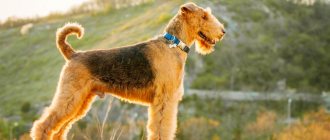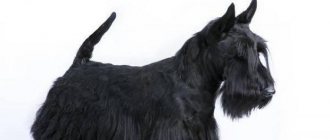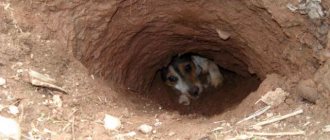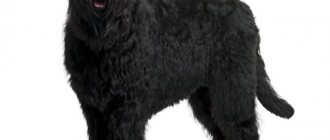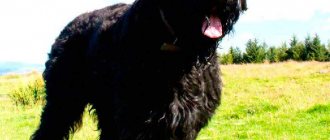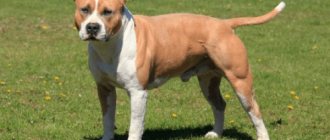The appearance of the Scotch Terrier makes you smile tenderly. Little bearded men are captivating with their appearance and character, they are “on their own” and know how to stand one step above their owner, which many people like. Life with a Scottish Terrier is a constant struggle for leadership, keeping both the owner and his pet in good shape.
Description of the Scottish Terrier breed
Popularity 110th place among 263 dog breeds
Lifespan:
12-15 years
Height:
25-28 cm
Country of origin:
Scotland
Average price:
40-50 thousand rubles
Weight:
males 8.5-10 kg, females 8.5-10 kg
Latest articles Cat health
Ataxia in cats: what it is, how it manifests itself and is treated 01/23/2022 151 0 0
Cat health
Leukemia, or viral leukemia in cats 01/23/2022 140 0 0
Advantages and disadvantages
- Pros:
- Scotch terriers become very attached to their owner and love him for the rest of their lives;
- these kids make excellent hunters and guards;
- You can keep a dog even in a small apartment.
- Minuses:
- due to excessive activity, the puppy will quickly chew up everything that the careless owner left on the floor;
- the dog needs constant communication and long walks;
- The process of training a Scottish Terrier is not an activity for an inexperienced breeder.
Key facts
Despite their small size, these dogs are quite hot-tempered and touchy. One of these kids’ favorite things to do on walks is pick on large dogs. Because of this, Scottie often gets into trouble and can even get seriously injured.
The characteristics of the Scotch Terrier breed mention that the dogs have a pronounced Napoleon complex. Such a dog will not turn out to be a couch potato. He will always be busy with something, and if the owner does not participate in this, then most likely it will be his things or everything that the dog could get to.
These babies don't like to be cuddled or laid on your lap. They need to play, bark and have fun. However, they are quite proud, so no amount of treats and praise will turn them into a toy for small children. The description of the Scotch Terrier breed especially emphasizes this.
If you managed to raise a Scottie correctly, he will not depend on you around the clock. This dog will spend time calmly at home, waiting for you from work, and then happily go for a walk. A stubborn and ill-mannered pet can turn an entire house upside down.
Despite its fragile health, the life expectancy of the Scottish Terrier is high and can reach up to 15 years. This means that a dog in old age needs good care.
History of the origin of the Scotch Terrier
Scotties are the oldest dog breed in Scotland. However, they managed to stand out from other terriers and show themselves only in the 19th century. It was then that the terrier breed was divided into short-haired Scottish and long-haired English.
Different breeds stopped crossing with each other, but for several decades they were not distinguished and all dogs that caught rats and were used in hunting small game were called Scottish terriers. For these purposes, several breeds of terriers were constantly bred at once. Therefore, dogs of completely different breeds were constantly crossed with each other, which prevented the final formation of the breed.
Every English village of that time had its own "ideal" terrier, which in fact was just a mixture of genes from many other breeds. Due to such differences between individuals, it was difficult to derive a common standard for all.
In 1879, the English Kennel Club finally decided to formalize the Scotch Terrier as a separate breed. The classification was based on the coat color of the animals. A certain Captain McKee was etched in history as one of the breeders who played an important role in defining the Scotch Terrier. In 1880, he traveled around the country, visiting villages and buying dogs with black and wheaten coats from people. Thanks to this, after only three years it was finally possible to form a breed standard that separated from other, albeit very similar, breeds.
Scotties arrived on the North American continent at the end of the 19th century, but did not gain almost any popularity. One of the first people to own a dog of this breed was Franklin Roosevelt. After this, Scottish Terriers gained wild popularity.
Only at the beginning of the 20th century did Scottish dogs finally reach Tsarist Russia. All the nobility and representatives of the upper strata of society immediately drew attention to the outlandish dogs. But during the times of countless revolutions and the overthrow of the tsarist regime, their population quickly declined.
In the 30s of the same century, another attempt was made to bring terriers to Russia, but now the unexpected World War II prevented breeding. It was only by the 80s that relatively stable breeding of Scotch Terriers began.
Appearance of the Scotch Terrier
General impressions
These small, shaggy dogs seem incapable of causing anything but joy and tenderness after the first glance. However, their short legs, overgrown with long, ragged hair, are able to cope with digging even in the most dense soil. And although the kids cannot boast of impressive size, they cannot be called short either. They grow up to 25-28 cm, and the weight of the Scotch Terrier reaches 10.5 kg, regardless of gender.
Head
The Scottie's skull is long and flat with a distinct, pronounced stop.
Despite the small size of the Scotch Terrier, the dog’s teeth are large and closed in a tight bite so that the upper row of incisors completely buries the lower one.
The nose is large, completely black, the line from the lobe to the chin is slightly sloping.
The eyes are set wide and almond-shaped. The iris is dark brown. The look is inquisitive, the eyes are slightly covered with massive eyebrows.
The ears are very thin, but erect and pointed.
Neck
The muscular neck is not too elongated.
Torso
The Scotch Terrier has an almost flat, short back. The chest is wide, voluminous, protruding forward and downward. This can be clearly seen in the photo of the Scottish Terrier in profile.
Forelegs
The front legs are short, clawed, and have straight pasterns.
Hind limbs
Hind legs with large, muscular thighs and short hocks. The pads on the paws are large and moderately hard.
Tail
The long, 16-18 cm tail is slightly thickened at the base, carried vertically, but a slight tilt is acceptable.
Movement
With their short legs, Scotch Terriers are able to overcome medium-distance forced marches. Their hefty endurance allows them to dig holes for an hour and a half after a 10 km run. And this is far from the limit of their abilities.
Wool
Scotties have a dense, short undercoat that lies close to the body. The outer hair is moderately long and dense. It reaches its greatest length on the stomach and sides, forming something like a “skirt”.
Color
The correct colors of the Scotch Terrier are black or wheaten in all its variants. Brindle color is also acceptable.
Size
Regardless of gender, Scotties grow up to 25-28 cm and reach 10.5 kg in weight. Excessive growth of a Scottish Terrier may be a reason for disqualification from exhibitions.
Collie breed color
Collie - bright color
There are three officially recognized colors:
- Sable with white (light golden to rich mahogany, dark sable. Light straw or cream are not desirable)
- Tri-color (black with red markings on the legs and head. The rusty shade of the guard hairs is undesirable).
- Blue Merle (pure silvery blue, spattered with dark spots, reminiscent of marble. Bright red tan marks are preferred, their absence is acceptable. Large dark markings, slate or rusty tint to the guard or undercoat are undesirable).
All colors may have white markings.
The most common: a white collar in whole or in part, a white chest, toes on the paws, a white tip of the tail. A dent on the muzzle, on the forehead or along the head.
Character of the Scotch Terrier
Scotch cats are very attached to their owners. In addition, if the dog is in the right mood, he can happily take over the work of a living heating pad or lie in bed with you. Scotch terriers will never love or show attention only on command; they simply do not know how to do this.
The Scotch Terrier's character is characterized by incredible curiosity; therefore, dogs are in constant search of new sensations, impressions and knowledge. This is especially pronounced during walks. They sniff every passing person or animal. Even all the holes, potholes and holes will definitely be explored. And because of this, you should never let your dog off the leash. The baby may inadvertently fail and fall somewhere.
You should also keep dogs away from all kinds of lawns, flower beds and flower beds, otherwise they will be mercilessly destroyed and dug up. But at home, after a good walk, Scotty will behave like an example of English manners. He can spend hours thinking about something of his own, looking out the window, or sleeping on his bed.
Scotch terriers are not known for being excessively importunate. The dog will not interfere with you if he sees that you are passionate about something, be it work or watching a movie. He will come to you only when you call him or are free. He will wait patiently until you finish your business and lie down next to you, subtly letting you know that he wants attention.
For dogs of this breed, maintaining a bond with their owner is extremely important, so be sure to spend as much time with the dog as you can, involve him in joint activities, such as cleaning, or exercise frequently. Scotty loves spending time outdoors, so if possible, you can replace the usual cooking dinner with barbecues in the fresh air.
A dog becomes smarter and develops only by communicating with a person. If the owner spends 14 hours a day at work and immediately goes to bed in the evening, not paying attention to the pet, he becomes stupid and withdraws into himself. A friendly, smart animal is unlikely to come from an animal that spends most of its time in an enclosure, because the owner is more busy with his life or work. Such a dog will grow up to be a nervous, uncontrollable fighter who will spoil your things at the first opportunity.
And fighting is a common thing for Scotch Terriers. They don't care about the size or strength of the enemy. Little dogs are so confident in themselves that they will fight selflessly until the last drop of blood.
Theses
- This is a smart, obedient, faithful dog. Infinitely devoted to family.
- They come in long-haired and short-haired varieties, both variations require care, but the long-haired variety requires more care.
- Many have drug sensitivities, which veterinarians are usually aware of. However, it is better to warn, since the reaction is unpredictable, including anaphylactic shock and death.
- They love children and play with them, they are a good nanny and friend.
- Clean, they nevertheless collect small debris with their fur during walks.
- They treat strangers with caution, but not aggressively. With proper socialization they are friendly, without it they are shy and timid.
Education and training
Scottish Terriers are as smart as they are stubborn. They do not take criticism at all, but they really love praise addressed to them. This will be useful for you to start learning. At first, the terrier will actively try to follow all your instructions, but over time, his enthusiasm will fade, the activities will become a routine for the dog, and he will try with all his might to switch to something more interesting. Therefore, raising and training a Scottish Terrier should turn into an exciting activity.
Scotties follow some commands with more enthusiasm than others. This is a manifestation of not the best trait of the breed - selectivity. They like active actions; even as a puppy, a terrier can easily master the commands “Look!” or “Fetch!”, but with the seemingly simple “Sit!” or “Lie down!” things are tight. You have to constantly concentrate their attention with the help of treats, because other methods of training do not work on these smart guys at all.
There is no universal training program for all Scottish Terriers: each dog has a unique character and habits. Classic methods are a waste of time, according to experienced breeders, so you have to act according to the situation. Try to combine play and study so as not to force your pet with boring exercises and not develop in him an aversion to exercise.
Try to conduct classes in a place with a minimum of distractions. If the dog is tired, the session will have to be interrupted. The Scottish Terrier is not one of those who will forcefully follow commands - he is too willful. There is no use going to the training ground with him. Too long monotonous actions will quickly exhaust the animal and after just a few trips he will completely refuse to follow commands.
From childhood, teach your Scottie to walk on a leash, because his hunting instincts are impossible to keep track of. You can start taking your puppy for walks as early as 2.5-3 months. Playful kids, despite their size and age, destroy everything they can reach. This is normal, so it's best to hide all expensive shoes, remove carpets from the floors and things that can be broken or chewed by small growing teeth.
Repairs should also be temporarily abandoned. Most likely, it will be needed when your terrier matures and stops acting like a little hurricane. As a last resort, you can always discourage the dog by lightly spanking him with a rag or newspaper. But this only works when the dog understands why he is being punished.
At a young age, Scots love to bite, but under no circumstances should this be left unattended, otherwise the habit will remain in adulthood. Do not yell at the puppy: he will definitely perceive this as an additional reason for offense.
Don’t expect your Scottish Terrier to learn at least one command from the very first training. Representatives of this breed think first and only then do something. And if your command seems meaningless to the dog, it is unlikely to obey. Don’t burden your puppy with countless repetitions of the same action; it’s better to dilute the activity with an exciting game.
Although this breed is a hunting breed, now almost no one uses small terriers for hunting. This is not due to a loss of instinct, but rather due to the owners’ reluctance to spend time on this. Mini-hunters have long turned into glamorous pocket dogs, which hardly anyone will allow to pick in the ground or run through the forests.
But if you don’t mind spoiling the appearance of your terrier, attend special dog training classes. In a month or two, this gentleman will be reminded of what his natural essence is, and now you have in your house a master in catching foxes and small animals.
Key points in training
Scotch cats are stubborn, but have good mental potential; they can often be found in the circus arena or in street shows. They learn easily if they are attached to their owner and listen to him. Therefore, the first point of training is education.
The owner needs to prove his leadership, show firmness and perseverance.
You can’t beat or humiliate your pet. Scotties feel all the intonations of their voice, so they easily pick up on the mood and quickly understand where they did something wrong.
- Training begins with a puppy of 2 months. They teach him simple rules of behavior: don’t jump on beds, don’t beg, etc. After establishing a reliable connection with a person, the Terrier will obey and follow commands, but will require encouragement.
- From 4 months , when the pet learns its name, you can begin to learn the basic commands: near, not allowed, place, voice, quiet.
Read about how to properly train a dog in the article: “Training a puppy: effective methods from dog handlers, learning commands at home.”
If you plan to raise a dog for hunting purposes, then it must be raised by trained people.
Health and disease of the Scottish Terrier
Possible diseases
There are several diseases to which Scotties are particularly predisposed:
- hemophilia (incoagulability of blood);
- achondroplasia (bone growth disorder);
- muscle spasms;
- Cushing's syndrome (hormonal disorder);
- dysplasia (destruction of joints);
- retinal atrophy;
- pulmonary artery stenosis.
However, some of them can be detected in puppies immediately after birth through tests, but others make themselves felt when the dog is already three or four years old.
Reproductive health
Estrus in Scotch Terriers begins early, already at the age of 9-10 months, but it is recommended to breed them at the age of 1.5 years for females and 2 years for males. Otherwise, you can’t count on healthy offspring.
Experts advise spaying and neutering your pets if you do not plan to closely monitor their breeding. The fact is that sexually transmitted diseases are not uncommon among representatives of this breed. Sterilization solves this problem.
These dogs usually give birth to from 6 to 10 puppies, but their number depends largely on the male, his feeding diet and the frequency of mating.
Mating
In a year, a male can fertilize about 40 females, but it is recommended to give birth no more often than once every 2 years, especially since the breed is characterized by difficult births. Pets begin to knit at 20-25 months, although they reach sexual maturity at 8-10 months. The main criterion is the bitch’s readiness to bear offspring. The best time for conception is considered to be 13-15 days of the third mating. At this time, signs of readiness appear: a loose loop, light discharge, playful behavior.
If the pets are breeding, they are bred through the nursery. There, the owners fill out forms and find a suitable candidate. Animals must complement each other's shortcomings with their advantages. The owners agree on the date and price.
On the appointed day, the female is brought to the male. Animals are small and do not require much space. But due to their specific constitution, pets need help. For the first time, you should invite a specialist.
The dogs are given 10-15 minutes to get to know each other. If the female allows the cage to be mounted, half the job is done. Otherwise, you can try the next day or find another candidate. Sexual intercourse takes from 10 to 20 minutes. If there is no lock, it is better to repeat the mating after 48 hours.
Read a detailed article on the topic: “Everything you need to know about breeding dogs: appropriate age, what to do if it doesn’t work out, rules and tips.”
Features of feeding and diet
Terriers are extremely selective in food. Particular attention should be paid to meat. Under no circumstances should Scotties be fed pork or lamb - this has an extremely adverse effect on their liver and in 100% of cases causes diarrhea. But raw beef is an excellent choice.
If desired, it can be replaced with boiled offal, but not more than three times a week. Raw skinless chicken or turkey can also be a nice addition.
Once every 1-2 weeks you can pamper your dog with boiled sea fish fillet. The daily menu must include low-fat cottage cheese or cheese. Garnish: buckwheat or oatmeal porridge with carrots and chopped raw cucumber. Sometimes you can diversify the menu by replacing any of the cereals with rice. Every other day, add a little bone meal (but never whole bones) or feed from a pet store to your dog's food.
Dry food should be chosen at least super-premium class. With this diet, no additional additives or feeding are required.
The serving size depends on the activity of the dog. If your baby has lost weight, increase the portion slightly. Well, if you start spending more time on the couch, cut it down.
Collie food
Nutrition for Collies
Up to six months, the number of daily feedings is 6. Then, over the course of a couple of months, the number of feedings is reduced to three. And closer to the year, the young animals are transferred to two meals a day, morning and evening. The water in the drinking bowl should be changed daily in the morning so that it is always clean.
The diet of Scottish Shepherds should include the following purely dietary products:
- lean varieties of beef and chicken;
- milk;
- eggs;
- cottage cheese;
- lean fish;
- vegetables.
The main food product is porridge, to which meat and offal, milk, vegetables and fish are added. A complex of vitamins necessary specifically for this breed of dog is also added to the porridge.
Care and maintenance
Scottish Terriers don't need a lot of space to feel comfortable. They live and feel great even in small apartments, but only on the condition that the owner regularly walks them.
It is better to choose a place for the dog next to a person. Let the puppy sleep next to your bed. At an early age, the Scottie will need constant close communication with the owner in order to establish a strong connection with him. In addition, this way the dog will quickly remember who its owner and teacher are.
It is better to buy a low bed with sides of about 10 cm, so that the dog is not exposed to night drafts. Toys should be present in the life of every pet, and tape is no exception.
If you have slippery floors in your home, it is better to cover them with newspapers or rugs to prevent the puppy's paws from moving apart, which could result in an incorrect gait. For the same reason, it is better to abandon the harness and take the puppy for walks on a leash from childhood. The harness can deform the forelimbs.
The Scottish Terrier is an active dog, and at a young age this activity is several times greater, so you need to walk the puppy every two to three hours, while at the same time teaching him to relieve himself outside the house. From six months onwards, you can take your dog on four walks a day, each lasting at least an hour.
Well, once you reach two years old, you can take your dog outside twice for 2-3 hours. If there is absolutely nothing to do outside for so long, walk more often, but make your walks shorter. For example, three times a day for 60 minutes.
Twice a year, the Scottie's undercoat changes, but the dog's main hair does not shed. Such dogs are not cut like other dogs - they are trimmed, giving the coat the desired shape. However, some breeders do not limit themselves to this and regularly pluck their animals, manually removing dead hair. This is usually done once a month. But you should accustom your dog to such procedures no earlier than 6 months of age.
If you decide to trim your pet's hair yourself, then don't make the mistake that most beginners make. They leave too much hair on their paws and sides. Scotty doesn't need fluttering fur. He is a hunter, not a lap dog.
In theory, you should wash your dog once a month using nourishing shampoo and conditioner. However, in reality it turns out that you have to take a bath every day, if not after every walk. Not only does the dog’s “skirt” catch all the dirt and debris, but the animal itself strives to explore all the holes and rummage thoroughly in the ground. The overalls solve the problem, but only partly. So a bath every day. Apart from this, the care and maintenance of a Scottish Terrier cannot be called extremely troublesome.
Behavior and temperament
Scottish terriers have the following positive qualities:
- Calm;
- Endurance;
- Courage;
- Independence;
- Cheerfulness;
- Insightful mind.
Negative features:
- Intolerance, sometimes aggressiveness towards other animals;
- Stubbornness;
- At a young age - playfulness.
Scotties must be trained from childhood, otherwise they grow up to be aggressive and overly wayward.
Tips for choosing a puppy
You can purchase a puppy if it is already 8 weeks old. However, at such a young age it is difficult to check the baby for compliance with the standards. Therefore, you will have to carefully choose an honest nursery. Be sure to check all documents before purchasing - this will help you avoid buying a puppy from an unplanned mating or unregistered.
If meeting the standard is your main criterion, there are breeders who sell 6-month-old dogs. However, the puppy will cost several times more than its younger fellow tribesmen.
As a child, the Scottie's head looks disproportionate to the rest of the body. However, this goes away over time. If this is not observed at the age of two months, then in the future the dog may not grow up completely healthy.
A healthy puppy should have clean ears, armpits and the area under the tail. No redness or dirt is allowed. A healthy puppy should behave actively in a group of relatives. You should not choose a child who has withdrawn from the group.
Pay attention to the dog's fur. If it is too abundant and lush, most likely it is a breed defect. Choose only smooth-haired Scotch Terrier puppies, without excess hair.
How to choose a puppy
A puppy can only be bought from nurseries that specialize in breeding the breed. If a person wants to get a healthy dog with a good nervous system, it is recommended to follow the advice.
The main indicator when choosing is the exterior and behavior of the puppy. Smooth, shiny fur smells pleasant, the skin color is soft pink - this indicates the health of the baby. The puppy’s eyes are somewhat moist and shiny; a sign of illness is a “film” on them. A healthy baby has pink gums and clean ears.
True breeding is manifested in the desire to be restrained, but at the same time to be interested in a stranger. When a puppy cowards, runs away, or growls with its tail between its legs, it has a weakened nervous system.
There is an opinion about the influence of color on the central nervous system: the white (wheaten) Scotch Terrier is hysterical and overly excitable. This is a deception; it is not the colors of the Scotch Terrier that influence the psyche, but its genetics, coupled with upbringing.
The price of an exhibition baby starts from 30,000 rubles . If you want to get a dog for yourself, its cost will vary from 20,000 to 25,000 rubles.
